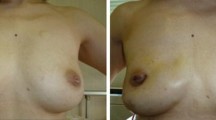Abstract
Background
Nipple-sparing mastectomy (NSM) has gained widespread popularity in recent years. Nonetheless, patient selection, technical consideration and oncological safety of its extension to breast cancer treatment remain uncertain. Few publications have reviewed the application of NSM in Asian populations.
Methods
We retrospectively reviewed 91 women with malignant breast tumours, who underwent 97 NSM in Hong Kong Sanatorium and Hospital from 2009 to 2015. Breast cancer patients who required mastectomy and opted for immediate reconstruction were considered for NSM if they showed no obvious nipple involvement clinically. All breast specimens were subjected to intraoperative pathological examination of the retroareolar tissue to exclude occult tumour infiltration before the final decision of nipple–areola complex (NAC) preservation. Clinical parameters, tumour characteristics and oncological outcomes were analyzed.
Results
Carcinoma of the breast accounts for 99.0% of our indications for therapeutic NSM. Almost all NSM were accompanied with immediate reconstruction. Abnormal pathology was shown in retroareolar tissue of ten patients (10.3%), and seven of these NAC were excised due to tumour involvement detected by intraoperative frozen section. Six (6.2%) NSM were complicated with superficial epidermolysis. Yet, there was no delayed NAC excision because of nipple necrosis. Overall NAC preservation rate reached 92.8%. Local and/or distant recurrences occurred in four patients (4.1%) after a mean follow-up of 20.6 months. One NAC recurrence was documented.
Conclusion
Our series support the oncological safety of NSM after exclusion of neoplastic NAC involvement preliminarily by intraoperative frozen section and definitively by final pathology. Its technical feasibility is well proven by the low nipple necrosis rate.
Similar content being viewed by others
References
Wei CH, Scott AM, Price AN et al (2016) Psychosocial and sexual well-being following nipple-sparing mastectomy and reconstruction. Breast J 22(1):10–17
Harness JK, Vetter TS, Salibian AH (2011) Areola and nipple–areola-sparing mastectomy for breast cancer treatment and risk reduction: report of an initial experience in a community hospital setting. Ann Surg Oncol 18:917–922
Chang RYK, Cheung PSY (2017) Nipple preservation in breast cancer associated with nipple discharge. World J Surg 41:176–183. doi:10.1007/s00268-016-3679-7
Lai HW, Chen DR, Wu YC et al (2015) Comparison of the diagnostic accuracy of magnetic resonance imaging with sonography in the prediction of breast cancer tumor size: a concordance analysis with histopathologically determined tumor size. Ann Surg Oncol 22:3816–3823
Garcia-Etienne CA, Cody HS, Disa JJ et al (2009) Nipple-sparing mastectomy: initial experience at the Memorial Sloan-Ketterinng Cancer Center and a comprehensive review of literature. Breast J 15:440–449
Gerber B, Krause A, Reimer T et al (2003) Skin-sparing mastectomy with conservation of the NAC and autologous reconstruction is an oncologically safe procedure. Ann Surg 238:120–127
Wagner JL, Fearmonti R, Hunt KK et al (2012) Prospective evaluation of the nipple–areola complex sparing mastectomy for risk reduction and for early-stage breast cancer. Ann Surg Oncol 19:1137–1144
Niemeyer M, Paepke S, Schmid R et al (2011) Extended indications for nipple-sparing mastectomy. Breast J 17:296–299
Sood S, Elder E, French J (2014) Nipple-sparing mastectomy with implant reconstruction: the Westmead experience. ANZ J Surg 85:363–367
Piper M, Peled AW, Foster RD et al (2013) Total skin-sparing mastectomy: a systematic review of oncologic outcomes and postoperative complications. Ann Plast Surg 70(4):435–437
Ponzone R, Maggiorotto F, Carabalona S et al (2015) MRI and intraoperative pathology to predict nipple–areola complex (NAC) involvement in patients undergoing NAC-sparing mastectomy. Eur J Cancer 51:1882–1889
Sakamoto N, Fukuma E, Higa K et al (2009) Early results of an endoscopic nipple-sparing mastectomy for breast centre. Ann Surg Oncol 16:3406–3413
Rivolin A, Kubatzki F, Marocco F et al (2011) Nipple-areola complex sparing mastectomy with periareolar pexy for breast cancer patients with moderately ptotic breasts. J Plast Reconstr Aesthet Surg 65:296–303
Lambert PA, Kolm P, Perry RR (2000) Parameters that predict nipple involvement in breast cancer. J Am Coll Surg 191:354–359
Laronga C, Kemp B, Johnston D et al (1999) The incidence of occult nipple–areola complex involvement in breast cancer patients receiving a skin-sparing mastectomy. Ann Surg Oncol 6:609–613
Pirozzi PR, Rossetti C, Carelli I et al (2010) Clinical and morphological factors predictive of occult involvement of the nipple–areola complex in mastectomy specimens. Eur J Obstet Gynecol Reprod Biol 48:177–181
Rusby JE, Brachtel EF, Othus M et al (2008) Development and validation of a model predictive of occult nipple involvement in women undergoing mastectomy. Br J Surg 95:1356–1361
Smith J, Payne WS, Carney JA (1976) Involvement of the nipple and areola in carcinoma of the breast. Surg Gynecol Obstet 143:546–548
Wang SY, Peng DF, Cai ZG et al (2008) Clinicopathologic analysis of the nipple–areolar complex occult involvement in early stage breast carcinoma. Zhonghua Zhong Liu Za Zhi 30:203–206
Li W, Wang S, Guo X et al (2011) Nipple involvement in breast cancer: retrospective analysis of 2323 consecutive mastectomy specimens. Int J Surg Pathol 19:328–334
Gerber B, Krause A, Dieterich M et al (2009) The oncological safety of skin sparing mastectomy with conservation of the NAC and autologous reconstruction: an extended follow-up study. Ann Surg 249:461–468
Rusby JE, Smith BL, Gui GP (2010) Nipple-sparing mastectomy. Br J Surg 97:305–316
Caruso F, Ferrara M, Castiglione G et al (2006) Nipple sparing subcutaneous mastectomy: 66 months follow-up. Eur J Surg Oncol 32:937–940
Sacchini V, Pinotti JA, Barros AC et al (2006) Nipple-sparing mastectomy for breast cancer and risk reduction: oncologic or technical problem? Am J Surg 203:704–714
Crowe JP Jr., Kim JA, Yetman R et al (2004) Nipple sparing mastectomy: technique and results of 54 procedures. Arch Surg 139:148–150
Voltura AM, Tsangaris TN, Rosson GD et al (2008) Nipple-sparing mastectomy: critical assessment of 51 procedures and implications for selection criteria. Ann Surg Oncol 15:3396–3401
Spear SL, Hannan CM, Willey SC et al (2009) Nipple-sparing mastectomy. Plast Reconstr Surg 123(6):1665–1673
Author information
Authors and Affiliations
Corresponding author
Ethics declarations
Conflict of interest
The authors declare no conflict of interest.
Rights and permissions
About this article
Cite this article
Chan, Y.HY., Yau, WM. & Cheung, P.SY. Oncological Safety and Technical Feasibility of Nipple-Sparing Mastectomy for Breast Cancer: The Hong Kong Experience. World J Surg 42, 1375–1383 (2018). https://doi.org/10.1007/s00268-017-4197-y
Published:
Issue Date:
DOI: https://doi.org/10.1007/s00268-017-4197-y




